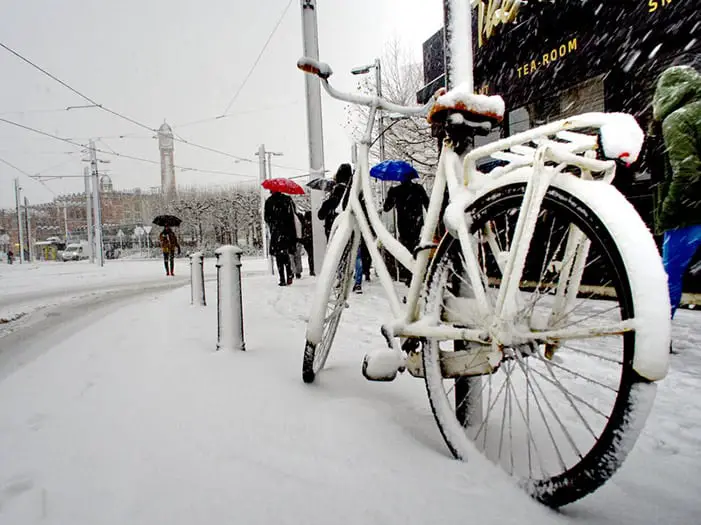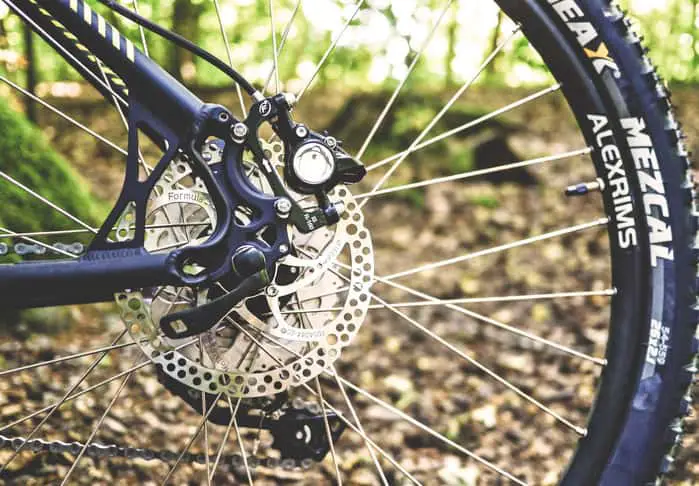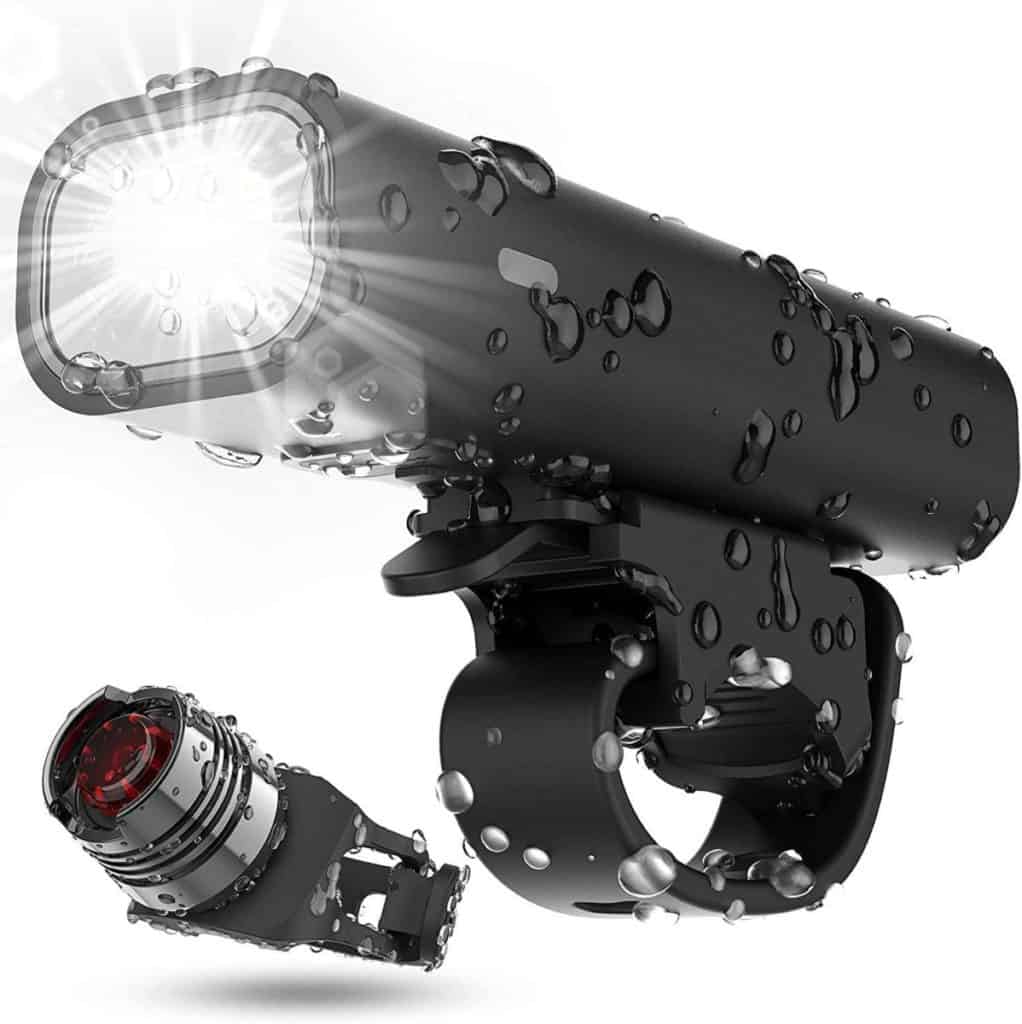
Having to stop biking and find another way to commute because winter is approaching is a thing of the past. Today, with the advancements in gear, clothing, and accessories, you can easily face even the most challenging weather conditions while commuting on your bike and not have to worry. But how do you prepare for bike commuting in the winter months?
Bike commuting in winter presents challenges such as poor visibility, adverse weather, and poor road conditions, you will need to prepare by getting the right tires and brakes, and switching to a wet-weather lube. Furthermore, you should invest in multiple layers of protective clothing and make sure the bike has lights to increase visibility.
Read on to start getting ready for a comfortable winter bike commute!
Considerations to Make Before Bike Commuting in Winter
Bike commuting in winter is not an extreme sport, but it comes with several obstacles that must be considered before attempting your first ride. Before diving into the accessories and equipment you will need for a safe and comfortable ride, you should keep in mind that most of these change depending on your lifestyle.
Therefore, before heading to the fist cycling gear shop, make sure you know what the items you genuinely can not do without are. And of course, keep in mind the ones that are nice accessories, but you don’t strictly need to buy them.
How Long Is Your Commute?
The length of your commute and the types of road you will be riding on are essential factors to consider. If your commute is only 5 to 10 minutes long and you are only riding through well-lit urban roads, you can make do with just a few extra layers, a pair of gloves, and long underwear.
However, if you are facing a 30-minute bike ride through countryside roads and heavy urban traffic, things change. In this case, you might need to consider investing in proper gear and checking your bike thoroughly before attempting your first ride.
The countryside and less-trafficked suburban roads tend to be poor-lit and more dangerous, requiring proper lighting on your bike. Instead, city-center streets and cut-through roads are usually better maintained and adequately illuminated.
What Is the Average Winter Climate Where You Live?
Not all winters are the same or boasting the same type of climate. If you commute between two towns in Northern Europe, you might need to be ready for heavy snowfall and below-zero temperatures. However, if you travel from a commuter’s belt town into the center of London, the climate can be more forgiving and will not require you the same pieces of equipment.
If this is the case of your commute, you should consider heavy rains and low temperatures, but heavy snowfalls are a rare occurrence. Therefore, investing more in mudguards, anti-slip shoes, and water-resistant jackets is more convenient than buying sunglasses for skiing.
What Time of the Day Will You Commute?
Even if the winters in England can be considered mild, don’t forget that the sun will rise later than 8 am and set before 4 pm. Unless you are working part-time, you are likely to be cycling home after dark, at least sometimes.
In this case, you should keep in mind the regulations regarding bike riding after sunset or in situations of poor road visibility. These indicate that your bike should be equipped with front, rear, and pedal reflectors. However, they also require you to implement a front white light and a rear orange or red light.
Even if you are sure that you won’t be travelling after dark, the road’s visibility conditions can be poor even during the day – for example, during rainfall or fogginess. If your bike is already equipped with such lights, everything you need to do is switch them on!
What Is Your Budget?
Getting ready for your upcoming winter commute might require a significant investment from your part, usually upfront. However, it is also true that biking to work rather than spending on fuel or public transport tickets can help you save a surprising amount of money.
Nonetheless, it is crucial to stick to your budget and opt for durable products – so next winter, you won’t face the same expenses. Alongside this, don’t forget that you simply won’t need some of the items on this list if the road conditions don’t call for them.
Getting Your Bike Ready for Winter Riding
Firstly, you should look at your bike and assess whether it is ready for winter. This might require you to change the lube, tires, and brakes before attempting your first ride. This preliminary analysis reduces the risk of accidents caused by a bike that is not braking correctly or is too slippery on wet surfaces.
Switch to Wet-Weather Lube
Independently on the weather, you would be using lube on your bike’s chain. This allows the cogs to overcome mechanical resistance, ensures the string to be well-maintained, and keeps the drivetrain healthy and reliable. Adding lube to your chain is part of the basics of bike maintenance, and you probably would not be able to enjoy an as smooth riding experience without.
However, during the winter months, the rain, fog, and hail can cause the lube to be washed off easily, leaving the chain to run poorly. Investing in a wet-weather lube and taking care of the drivetrain is essential to ride safely in such weather conditions. Also, you can take the opportunity to learn more about how to lubricate your bicycle in the video below:
Assess Your Tires
Most bikes today benefit from all-season tires that allow you to ride safely independently on the weather conditions. However, if you have been riding your bike throughout the summer, it is time to take a closer look at them.
Indeed, even all-season tires, if worn, can represent a safety hazard. They can become slippery and lose their grip, especially to wet surfaces. Investing in winter tires can help you ensure you are safe on the road while leaving the summer tires ready for the next season.
The importance of such swap derives from the fact that winter tires are made with a different rubber compound from the ones from summer. You might experience a decrease in performances, as speed is sacrificed in favour of better grip and friction – even in wet surfaces.
Check the Tires’ Pressure
Proper tire pressure is essential all year round, but it becomes paramount during the winter months. Appropriate pressure allows you to ride smoothly and avoid punctures, but the perfect pressure to apply depends on several characteristics, such as your weight and the bike’s specifics.
Generally, road tires are correctly inflated at a pressure of 80 to 130 psi. However, the higher the pressure, the less friction the tire will have with the floor, especially if wet. Therefore, if you have always pumped your tires to the upper tier, you should opt for lower pressure in winter.
Inspect Your Brakes

Properly functioning brakes are life-saving features that no rider can afford to overlook. This is especially true in harsh weather or during the winter months when you might need to brake at the last second due to poor road and visibility conditions.
Brakes alone won’t be able to eliminate the risk of accidents, especially if these happen due to the rider’s error or distraction. However, they can represent a safety net for you and the ones around you.
Add Fenders to Your Bike
Mud and rain on the floor can splash your clothes, bags, and valuables without fenders or mudguards. These are inexpensive accessories, and you can also find retractable models that allow you to hide them away during good-weather days.
Safety While Bike Commuting in Winter
As we have seen, riding your bike in winter can present obstacles that you did not have to face during the summer. During this time of the year, implementing safety measures that can make your ride safer and more enjoyable is paramount. Start with the ones below.
Wear a Helmet
Currently, the UK regulations regarding bike riding don’t require riders to wear a helmet unless cycling along a highway. However, during the winter months, floors and surfaces might be wet or slippery, increasing the risk of losing balance and falling off your bike.
While such accidents are not necessarily life-threatening, wearing a helmet can decrease the risk of injuries, even if not severe. Additionally, it is crucial to understand that due to the reduced visibility conditions, other riders and drivers might fail to see you. Wearing a helmet adds that extra layer of protection that allows you to ride safely independently in the weather conditions.
Add Lights to See and Be Seen

As we have seen, the UK regulations require your bike to be fitted with a front and a rear light when cycling after dark or poor visibility conditions. Installing these lights before the start of the season allows you to be ready for any eventuality.
However, when it comes down to picking appropriate lights for your bike, opt for:
- A white front light that emits light at least 400 lumens – you might need less for urban riding, but if you are travelling in the countryside, this type of brightness allows you to better see the road ahead.
- An orange or red rear light for increased visibility – since it will boast less lumen than your front light, make sure that it can be set on a flashing mode to save battery and be more visible by others.
Make the Most of Reflectors
Reflectors should already be fitted on your bike. However, you can implement the ones already present with additional reflective bands around your arms and legs. Additionally, you could think about investing in a reflective vest. While this might limit your freedom of movement when wearing several winter layers, it can increase your visibility level.
Dressing for Bike Commuting in Winter
In the section below is a lift of the must-have items for your winter bike commuting. However, riders and commuters should keep in mind that the weather and climate conditions of where they live can make a difference in what garments they will need.
Invest in Thermal Clothes
Thermal clothes are those garments that help you regulate your body temperature. They create a resistant layer between your skin and the outside conditions, insulating your legs, torso, or arms from the weather. These clothing items tend to be more expensive than your standard outfit, but also particularly useful.
Some commuters face their ride without any of these, as long underwear and jeans might also do the job. However, thermal trousers and jackets can help you wear more appropriate and smart apparel.
Layer Up
Adding several layers to your outfit is one of the best strategies to fight the cold weather. Since cycling is a form of exercise, you might need to keep in mind that you will be sweating underneath your layers. Ideally, depending on the weather, you should wear:
- A hat or windproof fleece hat
- Wool base layer
- Wool shirt
- Windproof fleece coat or other windproof coats you are comfortable with
- Light windproof jacket on top to keep the cold wind off your skin
- Long underwear
- Jeans or thermal trousers
Invest in Sturdy, Non-Slip Shoes and Shoe Covers
When riding a bike in winter, you will need to have as much stability and balance as possible, especially when riding on wet or slippery surfaces. Of course, your bike and tires will be doing most of the job, but it is still essential to invest in sturdy, anti-slip shoes.
Additional Comfort While Bike Commuting in Winter
Some other winter bike commuting items you should consider investing in are:
- Glove liners and windproof mittens – these help you keep your extremity warm, which is paramount for better responsiveness and control of your bike.
- Purchase a headscarf or consider a facemask – a facemask such as the Seirus Innovation Neofleece Combo Scarf can keep you warm and protected from the element without impeding your breathing or fogging glasses.
- Sunglasses – while some riders do understand the benefits that ski sunglasses can bring to your riding experiences, any type of light glasses can work. Of course, you should make sure that they don’t decrease the level of visibility.
- Take care of your skin – the wind, rain, and cold temperatures can have a detrimental impact on your skin. Make sure you are looking after it with moisturizer and hydrating creams.
Obstacles That You Might Face When Bike Commuting in Winter
In the sections above, you have found out everything you need to know to ride your bike to work during the winter months. However, other necessities such as sturdier boots, or brighter front light purely depend on the conditions you are riding in. Therefore, it is essential to visualize the possible obstacles you will encounter on the way and prepare yourself at best to solve them.
Inaccessible Bike Lane
If you have been following a bike lane all summer, get ready to find alternative routes. While it might have been the best way to get to work so far, you should keep in mind that bike lanes often lie on one side of the leading car lane. Therefore, if it has been raining, snowing, or hailing, the parts of the road will be affected the most.
In many cases, you might be presented with a flooded lane. At the same time, fixing your phone at the front of your bike without an appropriate cover might cause damage to the electrics. Therefore, familiarizing yourself with alternative lanes can help you be ready for such eventualities.
Poor Road Conditions
Riding your bike in the dry condition is different from doing so when the floor is wet or raining. Surfaces, especially smooth ones, become suddenly much more slippery. While you will soon learn how to manage your bike on puddles and slippery surfaces, don’t underestimate the risk that curves and bends can represent. So, to stay on the safe side of things, avoid sudden movements, and test the area before riding through it at full speed.
Poor Visibility
This is arguably the main obstacle for a commuter. And not just for you, but also for the other drivers and riders on the road. While you want to avoid front and rear lights that are as bright as to dazzle others, you must make sure your bike is visible. When riding in locations that are not as trafficked or offer even worse visibility, travelling along with other cyclists can make you more visible.
Maintenance Issues
Due to the wet environment, you can start noticing rusting and oxidation in some metal parts of the bike. Leather details can also be affected by the climate, requiring you to increase the level of maintenance you are supplying to your bike. Since punctures and other issues are more common in winter, it is recommendable to always have a pump and a multi-tool device with you.
Conclusion
When bike commuting in winter, safety should be paramount. Even if you won’t have to face heavy snowfalls or hail, it is essential to understand the added risk that rain and fog can create. Therefore, investing in bike lights, a helmet, and a resistant reflector allow you to be more visible while riding.
However, don’t forget to wear several layers to stand the low temperatures. When doing so, ensure your extremities – such as your fingers – are covered and warm. You will need to keep your hands from becoming numb to ensure maximum responsiveness and freedom of movement.
Sources
- Legislation.gov.uk: The Road Vehicles Lighting Regulations 1989
- University of Kansas: Bicycle Maintenance
- Uniroyal: What is the difference between summer and winter tyres?
- Exploratorium: Tension not Compression
- We Are Cycling UK: Cycle helmets
- The Observer: The science behind winter clothing
- University of Iowa: Winter Biking Tips
- University of Montana: Winter Biking Tips
- University of Colorado: Winter Bike Commuting


